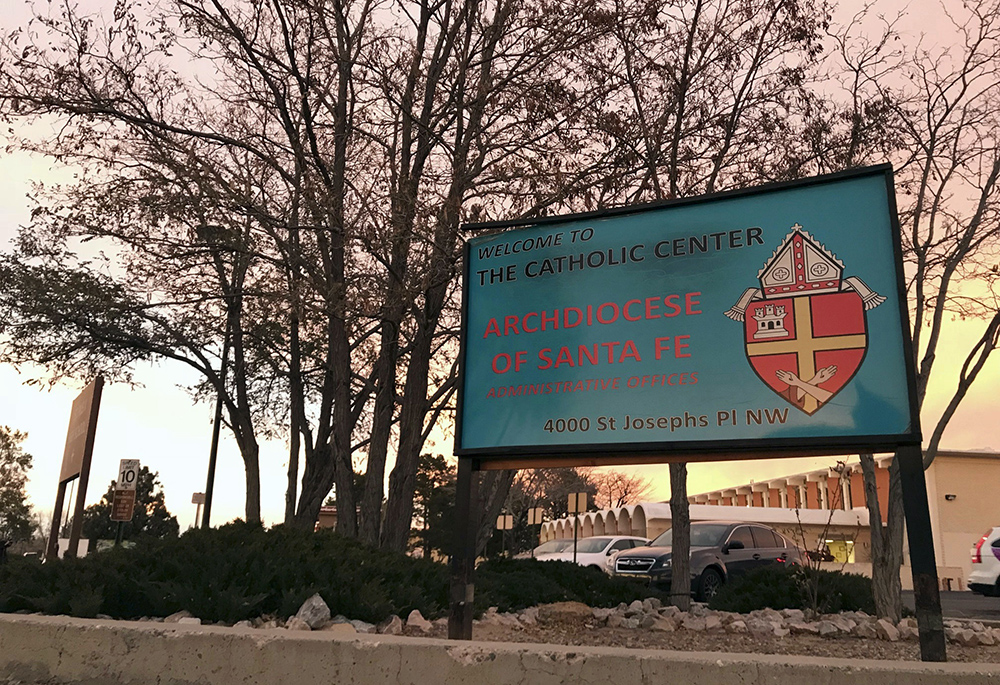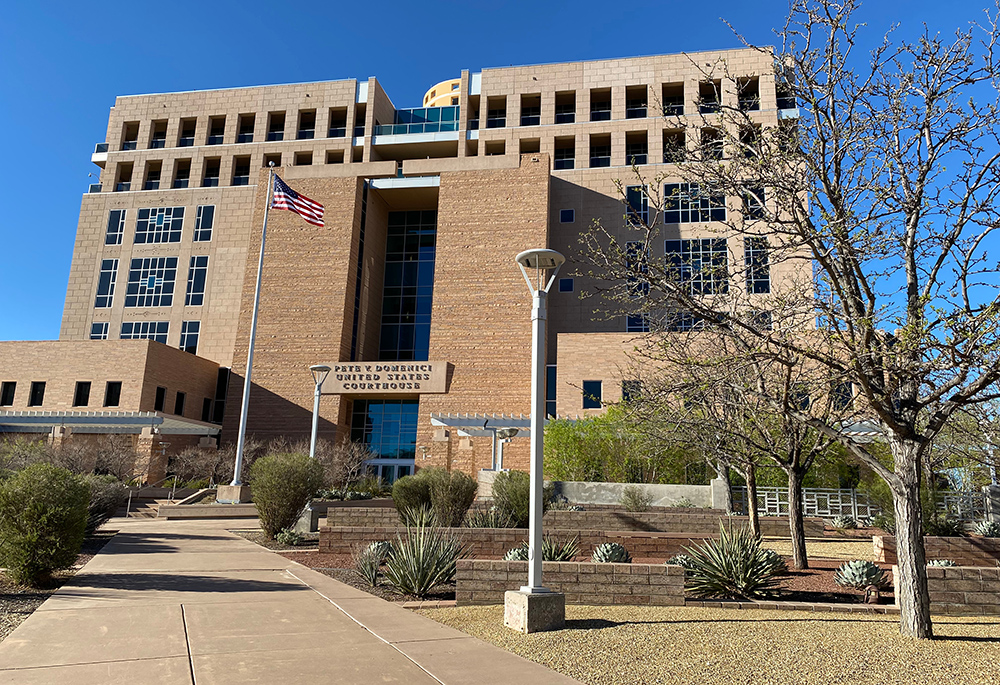
The Archdiocese of Santa Fe offices are pictured in Albuquerque, New Mexico, in a 2018 file photo. (AP photo/Susan Montoya Bryan, file)
When a New Mexico bankruptcy judge ruled against a clergy sex abuse claimant earlier this summer in her legal dispute with the Archdiocese of Santa Fe, he may have issued more than a routine legal opinion and order.
Judge David Thuma's decision may now serve as a cautionary warning to attorneys in other church bankruptcies — attorneys for both church entities and abuse claimants — about the challenges of enforcing provisions in reorganization plans and settlement agreements, especially the legal pitfalls posed by ambiguous language in those documents.
"The Court has reviewed the covenants, the confirmed plan, and related documents and has heard oral argument on the dispute," Thuma explained in his opinion on June 21, which was accompanied by a court order denying a motion by Mela LaJeunesse, an abuse claimant.
LaJeunesse's motion, filed by attorney Levi Monagle, was centered on a 142-word non-monetary covenant, one of eight pages of "stipulated non-monetary covenants," the archdiocese committed to in its agreement with sex abuse claimants in its plan of bankruptcy reorganization. The covenant, entitled "Publication of Accused List," includes a key sentence stating, "ASF [Archdiocese of Santa Fe] will update the list to include any clergy who are identified in any proof of claim filed in the Chapter 11 Case (unless the identification has been withdrawn in any amendment or supplementation to the Proof of Claim)."
LaJeunesse and Monagle interpreted that as "plain language," meaning the archdiocese was required to add the names of all accused abusers named in the proofs of claims to its credibly accused list — including Fr. Richard Spellman, the priest named in LaJeunesse's claim. Their motion also noted "more than fifty additional clergy" had been named by other claimants.
In her motion, LaJeunesse claimed she had been sexually abused as a child in the 1950s by Spellman. She eventually disclosed and received treatment for the abuse in 2016. She filed a sexual abuse proof of claim in the archdiocese's bankruptcy case in May 2019, and she received compensation through the archdiocese's settlement trust in January 2023.
The Archdiocese of Santa Fe, however, didn't add Spellman's name to its public list of credibly accused clergy.

The Pete V. Domenici United States Courthouse is pictured in Albuquerque, New Mexico. After a sex abuse claimant filed a motion in February claiming the Archdiocese of Santa Fe violated a non-monetary covenant it made with abuse survivors, the archdiocese returned to U.S. Bankruptcy Court. (Elizabeth Hardin-Burrola)
Email exchanges entered into the court record document Monagle's efforts to get the archdiocese to add Spellman's name. In an email dated Dec. 9, 2022, Monagle told an archdiocesan attorney that "Fr. Spellman's personnel file bears the clear hallmarks of an abuser." However, seven months later, on July 19, 2023, an attorney for the archdiocese notified Monagle the archdiocesan Independent Review Board, or IRB, convened in April and "recommended that Fr. Spellman not be put on the credibly abused list."
Spellman is deceased. Online newspaper archives indicate he was a pilot and former military chaplain who garnered media publicity for the Archdiocese of Santa Fe in 1964, after piloting a Lockheed F-104 Starfighter at reportedly twice the speed of sound. He later left the priesthood and married.
In court documents, the archdiocese argued LaJeunesse, as an individual abuse claimant, didn't have legal standing to seek enforcement of the covenant. It also disputed LaJeunesse's interpretation of the non-monetary covenant and its key sentence. Citing case law that Chapter 11 plans are to be interpreted "under the rules governing the interpretation of contracts," the archdiocese asserted under state law a court is not "restricted to the bare words of the agreement in interpreting the intent of the parties to a contract," but may also consider other factors such as the context in which the agreement was made.
The archdiocese asserted it "did not agree to cede control over its credibly accused list to allow for the automatic addition of the names of any clergy members identified in proofs of claims" without those names first being subject to examination by the review board established by the archdiocese.
In his opinion, Thuma agreed with the archdiocese's legal arguments. On the issue of standing, the judge cited the text of another non-monetary covenant: "The Committee and any trust created for the benefit of Sexual Abuse Claimants shall have standing and shall be authorized, but not directed, to seek enforcement of any of the terms of these non-monetary undertakings."
"The Committee" refers to the Official Committee of Unsecured Creditors, which represented the interests of abuse claimants in the bankruptcy case. It ceased meeting once the case concluded. The trusts Thuma cited, the ASF Settlement Trust and the Unknown Tort Claims Trust, are entities funded by the archdiocese in the bankruptcy. They were created to provide payment for allowed abuse claims after an independent tort claims reviewer approved them.
Advertisement
Thuma also agreed with the archdiocese's interpretation of the disputed non-monetary covenant. He did, however, acknowledge its language was ambiguous and noted all the covenants "needed, but did not receive, a careful and thorough editing."
"If many new perpetrators were added to the List without the 'credibly accused' determination process, the List would lose much of its significance," Thuma said. "Further, adding names of priests who were identified in a proof of claim could add names of clergy who have been wrongfully accused, or clergy who were never accused at all but were identified in a proof of claim for some other reason. Restricting the List to those who have been credibly accused, as determined by the IRB and the Archbishop, both protects innocent clergy and gives significant weight to the List. In its current form, the List is an admission of appalling wrongdoing."
Monagle, when contacted by NCR, expressed frustration with Thuma's opinion.
"Judge Thuma's decision made it clear that the involvement of the Committee and its attorneys would not have affected the ultimate outcome of this dispute, which boiled down to a question of textual interpretation," Monagle said in an email Aug. 9. "I think it is somewhat glib to posit that Committees of abuse survivors and their legal teams can be readily reassembled upon the resolution of a bankruptcy and the Committee's subsequent disbandment."
As for the language of the disputed non-monetary covenant that Thuma described as ambiguous, Monagle said that "dozens of drafts of the Plan of Reorganization were exchanged over a period of many months" between various attorneys. "I can say with some confidence that the final draft of the covenant was acceptable to both the Archdiocese and the Committee, based on their respective interpretations of its meaning," he added.
But the judge's ruling could put others considering legal action on notice: They may need significantly more specific language in any agreement or covenant in order to press a move forward in court.
While Thuma's ruling resolved this specific legal dispute, it did not resolve the related issue raised in LaJeunesse's motion — Monagle's assertion that "more than fifty additional clergy" were named as alleged abusers in the proofs of claims that haven't been added to the archdiocese's credibly accused list.
In previous comments to NCR in April, Monagle, whose law firm represented more than one-third of the approximately 400 abuse claimants in the bankruptcy case, explained those 50-plus claims represent over 12.5% of the total number of claimants — which he said represent approximately $15 million of the $121.5 million settlement pool.
NCR emailed questions to archdiocesan officials about those additional abuse claims. They were asked if those names represented credibly accused abusers — yet to be investigated and publicly identified, innocent individuals — mistakenly identified, innocent individuals — identified in fraudulent claims, or clergy credibly accused of sexual misconduct involving adult victims. None of the archdiocesan officials responded to the NCR, so information about those claims remains unknown.
NCR also contacted four attorneys with Pachulski Stang Ziehl & Jones LLP, the bankruptcy law firm that served as legal counsel for the Creditors Committee. None responded to NCR's request for comment.
Monagle, whose firm also worked with the archdiocese to establish a future public archive of clergy sex abuse documents at the University of New Mexico, was asked if he or LaJeunesse were planning any additional legal action.
"While we are not planning to pursue further action as to this relatively narrow question regarding Ms. Lajeunesse and Fr. Spellman, we are certainly prepared to pursue enforcement of the Plan's other non-monetary covenants if or when it becomes apparent that the Archdiocese is not keeping them," Monagle said. "The publication of the UNM Abuse Documents Archive will be an important opportunity to audit the good-faith efforts of the archdiocese to achieve meaningful transparency with respect to its role in the clergy abuse crisis in New Mexico."



